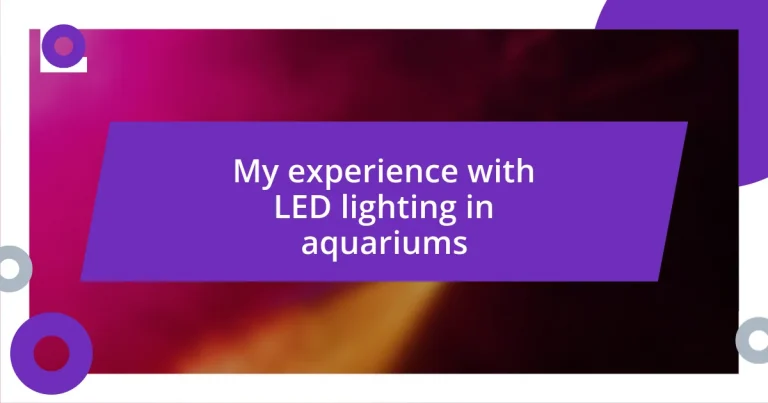Key takeaways:
- LED lighting enhances aquarium aesthetics, provides energy efficiency, and reduces maintenance costs due to longer lifespan.
- Choosing the right LED fixtures involves assessing light spectrum, wattage, dimensions, adjustability, and heat output to support aquatic life.
- Monitoring light intensity, duration, and color spectrum is crucial for maintaining the health of both plants and fish in the aquarium.

Understanding LED Lighting Benefits
LED lighting has transformed the way I approach aquarium maintenance. I still remember the first time I swapped out my traditional bulbs for LEDs; the vibrancy of the colors in my tank was breathtaking. It felt almost as if my fish were showcasing their true personalities for the first time, and that’s a moment I’ll never forget.
One of the standout benefits of LED lights is their energy efficiency. I was amazed when my electric bill came, significantly lower than I expected. Have you ever experienced that moment when you realize the switch to LEDs not only benefits your fish but your wallet too? It’s a win-win that can ease the burden of ongoing costs in maintaining an aquarium.
Moreover, the longevity of LED lights is impressive. In my experience, I haven’t had to replace them nearly as often as my old bulbs, which often burned out at the most inconvenient times. Isn’t it a relief to know that these little changes can lead to greater peace of mind in your hobby? They are not only an investment in your aquarium’s aesthetic but also in your overall enjoyment.
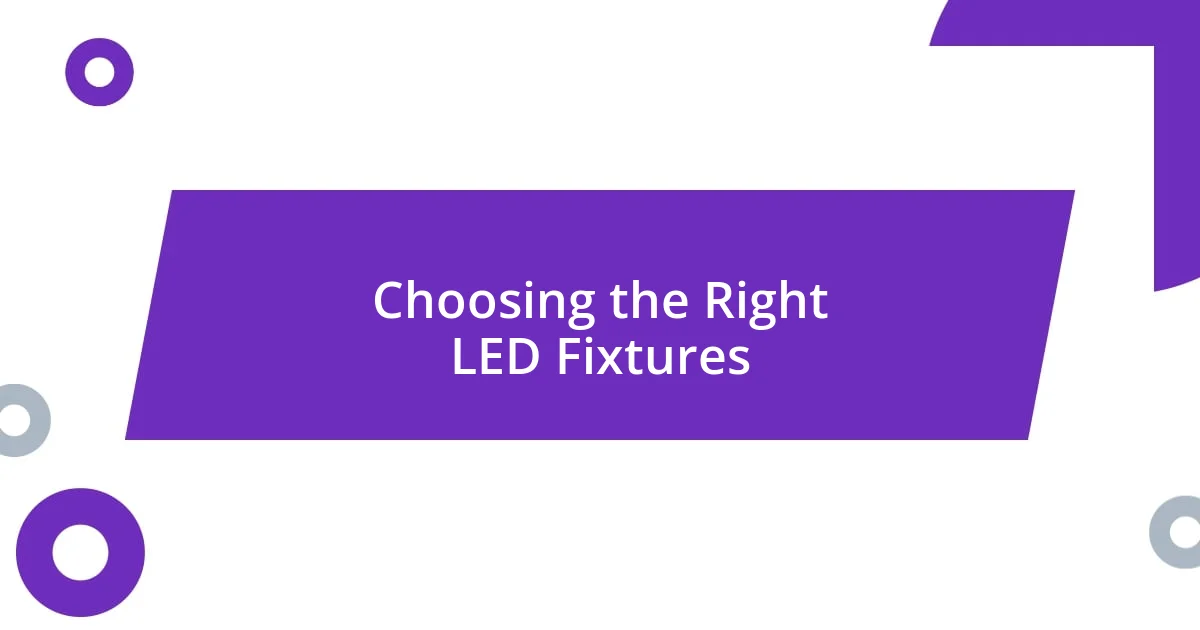
Choosing the Right LED Fixtures
When it comes to choosing the right LED fixtures for your aquarium, it’s crucial to consider both the size of your tank and the needs of your aquatic life. I fondly recall the moment I realized that not all LEDs were created equal. I initially opted for a model that looked sleek and modern, only to find out later that it didn’t provide sufficient light for my plants. It was a learning moment that highlighted the importance of selecting fixtures based on actual requirements rather than sheer aesthetics.
Here are some key factors to consider when selecting your LED fixtures:
– Light Spectrum: Ensure the fixture provides a full spectrum of light to support both plant growth and fish behavior.
– Wattage and PAR Value: Check the power output and Photosynthetically Active Radiation (PAR) ratings suitable for your tank’s depth and type of inhabitants.
– Dimensions: Match the fixture size to your aquarium dimensions to avoid uneven lighting.
– Adjustability: Look for options that let you dim or adjust the intensity, especially if your tank has a mix of species with varying light needs.
– Heat Output: LEDs typically produce less heat, but be mindful of your tank’s temperature—balanced heat in the aquarium is vital.
This thoughtful approach not only enhances the aesthetic appeal of your aquarium but nurtures a healthy environment for your fish and plants alike. Nothing beats the satisfaction of seeing your aquatic life thrive under the right lighting!
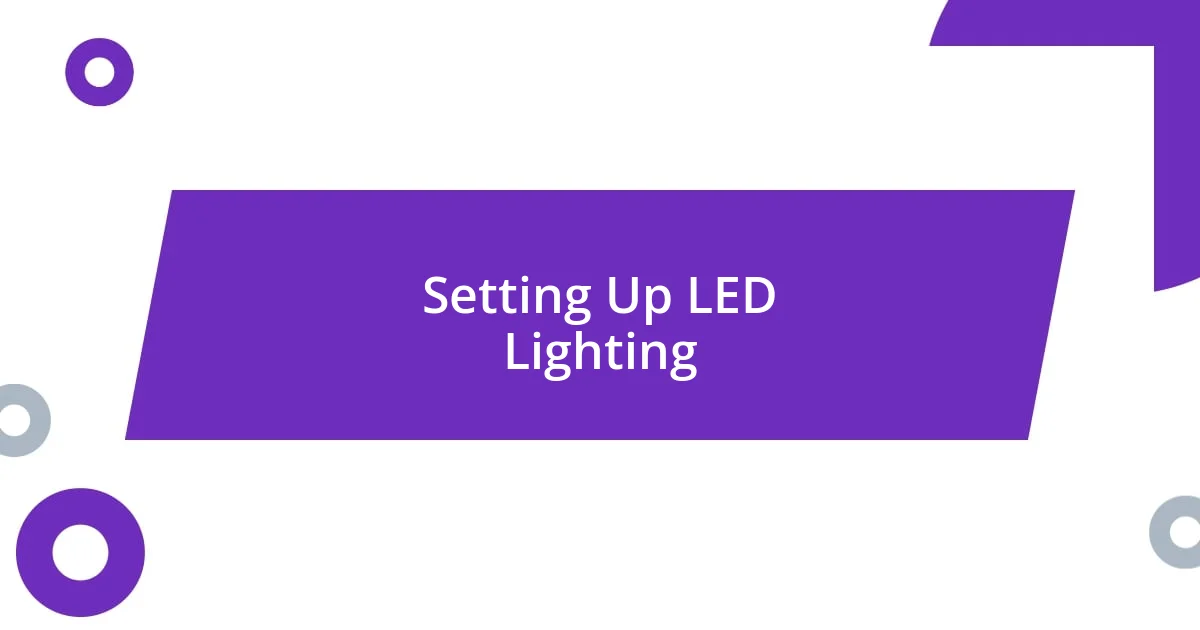
Setting Up LED Lighting
Setting up LED lighting in your aquarium can be a game-changer, but it does require some thoughtful planning. I remember the first time I installed my LED setup; it felt like setting up a new art exhibit in my living room. I was so eager to see how my fish and plants would respond to this upgraded environment. Paying attention to the layout of the lights ensured even distribution, so every corner of my tank was beautifully illuminated.
The placement of your LED lights matters greatly. After experimenting, I’ve found that having the lights mounted slightly above the water surface creates an appealing shimmer effect that mimics natural sunlight. It’s really about finding that sweet spot where beauty meets functionality. Plus, don’t forget to consider the timer settings; I learned that having a consistent day-night cycle mimics their natural habitat, creating a stress-free environment for my fish.
Another crucial point in setting up LED lighting is adjusting the intensity for different species. My neon tetras thrive with a moderate light setup, while my anemones require a more intense spectrum. Have you ever had to tweak the lighting setup multiple times before getting it just right? I certainly have! It’s a bit of trial and error, but the result—a vibrant, thriving aquarium filled with happy fish—is worth every effort.
| Aspect | LED Setup Considerations |
|---|---|
| Placement | Mounted above water for even light distribution. |
| Intensity | Adjust according to the needs of different species. |
| Timer Settings | Consistent cycles to mimic natural habitat. |
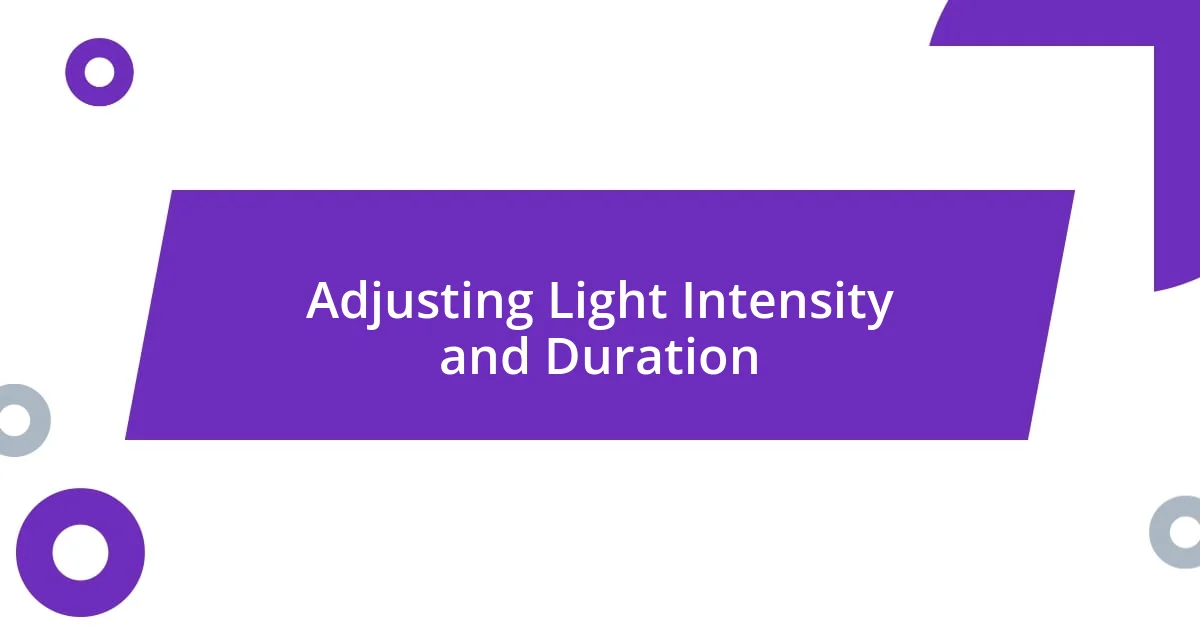
Adjusting Light Intensity and Duration
Adjusting light intensity and duration in your aquarium can be a bit of a balancing act, but it’s a journey worth taking. I vividly remember my first experience with tweaking lighting. I started with what I thought was the perfect setting, only to find my plants wilting within days. That moment taught me how crucial it is to monitor both the intensity of light and the duration it’s on. Too much light can promote algae growth while too little can stunt plant health. Finding the right balance took time, but it transformed my tank into a thriving underwater ecosystem.
In terms of duration, I found that using a timer was a game-changer. Initially, I would manually turn the lights on and off, which was not only inconvenient but often inconsistent. Once I set a reliable 8-10 hour cycle, my fish became noticeably more active and my plants began to flourish. It’s fascinating how quickly they adapt to a routine—almost like they knew when to prepare for “dinner time.” Have you noticed how a predictable light schedule can calm your aquatic friends?
I also learned that gradually adjusting the intensity as seasons change was essential for maintaining a healthy tank. In winter, my aquarium naturally received less light from the window, so I cranked up the LED intensity a bit to compensate, mimicking the vibrant light conditions of summer. Observing my aquatic life respond positively to these changes has been incredibly rewarding. Have you experimented with seasonal adjustments? I found it not only enhances their health but also enriches the visual appeal of the tank immensely.
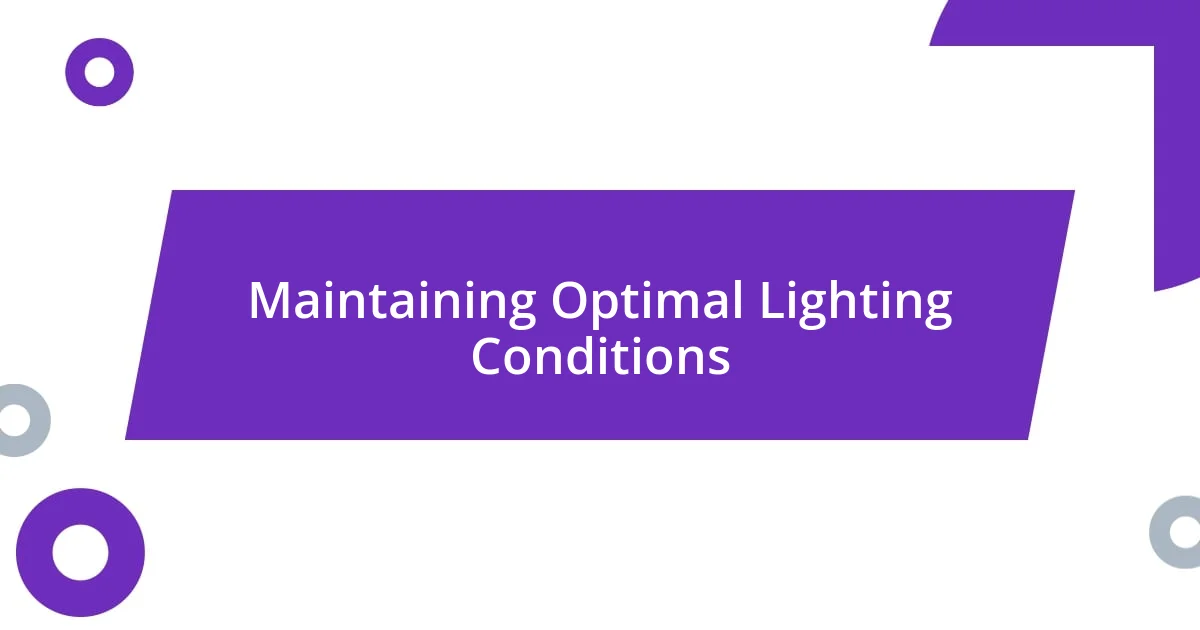
Maintaining Optimal Lighting Conditions
Maintaining optimal lighting conditions in your aquarium is essential for the well-being of both fish and plants. From my experience, I’ve discovered that regularly checking for any obstructions in light paths—like floating debris or algae buildup—can significantly impact overall illumination. I remember feeling frustrated when I noticed a drop in my plants’ health; it turned out some leaves had drifted into the beam. A simple clean-up made a world of difference!
Another lesson I learned was about the importance of colors. I experimented with different color spectrums, and I was honestly amazed by how much they affected the environment. Blue and red lights promote growth while creating a serene ambiance, reminiscent of a sunset in the wild. Have you ever tried mixing colors? I found that combining various spectrums not only kept my plants lush but also made my tank visually stunning.
Keeping an eye on the temperature is vital when you’re using LED lighting too. Initially, I was thrilled by the brightness but didn’t consider the heat generated. One day, I found my water temperature had spiked unexpectedly. It was a wake-up call! Now, I always ensure my lighting schedule aligns with cooler periods to keep everything balanced. How do you monitor the thermal effects of your lights? Finding the balance between lighting and temperature management has become one of my favorite aspects of maintaining my aquarium.
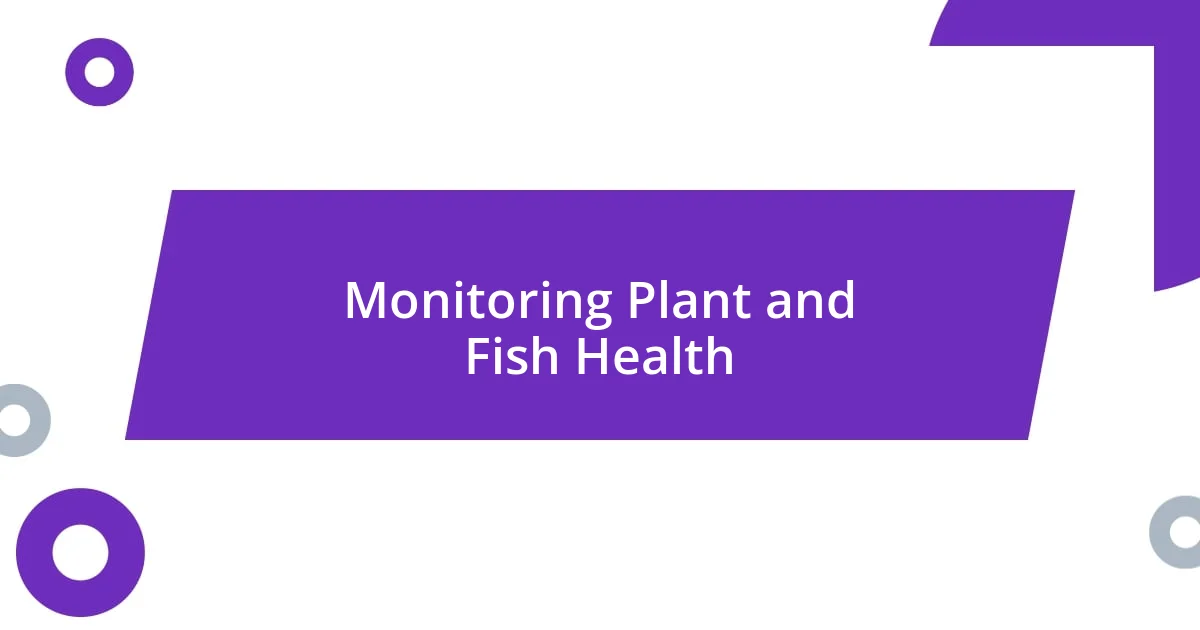
Monitoring Plant and Fish Health
Monitoring the health of your aquatic plants and fish is more than just a routine task; it’s an ongoing journey that deepens your connection with your aquarium. I recall a particularly striking moment when I noticed one of my favorite plants, the Java Fern, starting to show signs of distress. Its once vibrant green leaves were dull and drooping. After some investigation, I discovered that the overall light exposure was lower than optimal. Adjusting the light intensity not only rejuvenated that plant, but also sparked a wave of growth across my tank. Have you ever felt that twinge of concern for your plants that quickly shifts to joy when they bounce back?
Fish health is equally vital, and I often like to observe their behavior as much as their physical condition. I remember a week when my guppies seemed unusually lethargic. A closer look revealed that the light had been on for too long, leading to excess algae and affecting the water quality. Since then, I’ve made it a habit to monitor both their activity and the tank’s clarity. It’s fascinating how my fish have become more lively with slight tweaks to light management. Do your fish exhibit similar reactions when you make changes to their environment?
Finally, I’ve discovered that the colors of the LED lights can significantly affect not just plant growth, but also the mood of the aquarium. When I introduced a balance of warmer hues, it transformed the entire atmosphere, almost like setting the perfect stage. I found my fish were more active, engaging in playful displays that I had not noticed before. Have you considered how the light spectrum influences your aquarium? The right color settings can create a vibrant ecosystem where both flora and fauna thrive, making every day in front of the tank a new adventure.












